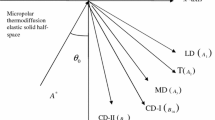Abstract
In the present paper, the linear theory of micropolar thermoelasticity without energy dissipation is considered. This work is organized as follows: Section 2 is devoted to basic equations for micropolar thermoelastic materials, supposed to be isotropic and homogeneous, and to assumptions on constitutive constants. In Section 3, some theorems related to representations of a general solution are studied.
Similar content being viewed by others
References
A. C. Eringen, “Foundations of micropolar thermoelasticity,” Int. Cent. Mech. Stud. Course Lect., No. 23 (1970).
A. C. Eringen, Microcontinuum Field Theories I: Foundations and Solids, Springer, New York (1999).
W. Nowacki, Theory of Asymmetric Elasticity, Pergamon, Oxford (1986).
E. Boschi and D. Iesan, “A generalized theory of linear micropolar thermoelasticity,” Meccanica, 7, 154–157 (1973).
A. E. Green and P. M. Naghdi, “Thermoelasticity without energy dissipation,” J. Elast., 31, 189–209 (1993).
M. Ciarletta, “A theory of micropolar thermoelasticity without energy dissipation,” J. Thermal Stresses, 22, 581–594 (1999).
M. E. Gurtin, “The linear theory of elasticity,” in: C. Trusdell (editor), Handbuch der Physik, Vol. VIa/2, Springer, Berlin (1972), pp. 1–295.
V. D. Kupradze, T. G. Gegelia, M. O. Basheleishvili, and T. B. Burchuladze, Three-Dimensional Problems of the Mathematical Theory of Elasticity and Thermoelasticity, North-Holland, Amsterdam (1979).
W. Nowacki, Dynamic Problems of Thermoelasticity, Noordhoff, Leyden (1975).
M. Ciarletta, “A solution of Galerkin type in the theory of thermoelastic materials with voids,” J. Thermal Stresses, 14, 409–417 (1991).
M. Ciarletta, “General theorems and fundamental solutions in the dynamical theory of mixtures,” J. Elast., 39, 229–246 (1995).
M. Basheleishvili, “Applications of analogues of general Kolosov-Muskhelishvili representation in the theory of elastic mixtures,” Georgian Math. J., 6, 1–18 (1996).
M. Svanadze, “Representation of the general solution of the equation of steady oscillations of two-component elastic mixtures,” Int. Appl. Mech., 29, 22–29 (1993).
M. Svanadze and R. de Boer, “Representations of solutions in the theory of fluid-saturated porous media,” Quart. J. Mech. Appl. Math., 58, 551–562 (2005).
Author information
Authors and Affiliations
Additional information
Published in Ukrains’kyi Matematychnyi Zhurnal, Vol. 59, No. 10, pp. 1391–1398, October, 2007.
Rights and permissions
About this article
Cite this article
Svanadze, M., Giordano, P. & Zampoli, V. On representations of a general solution in the theory of micropolar thermoelasticity without energy dissipation. Ukr Math J 59, 1560–1568 (2007). https://doi.org/10.1007/s11253-008-0012-0
Received:
Revised:
Published:
Issue Date:
DOI: https://doi.org/10.1007/s11253-008-0012-0




